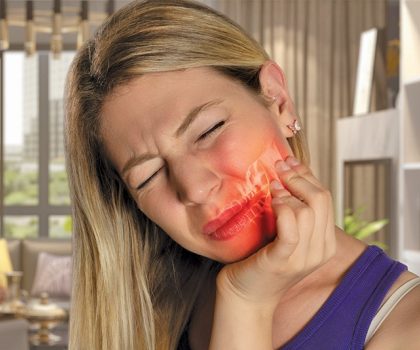If you are suffering from jaw, head or neck pain, Living Tree Center for Healing can help

By Beth Newcomb
You’ve got all the telltale signs…chronic jaw pain, headaches, a stiff jaw in the morning, and you’ve noticed ringing in your ears that just won’t go away. These, among others, says Dr. Nigel Brayer, of the Living Tree Center for Healing, are classic symptoms of TMJ (temporomandibular joint dysfunction of the jaw). And while most people might book a trip to the dentist for a mouth guard, that’s not going to make a permanent change, he notes.
“A mouth guard might help to keep teeth from wearing out, but it’s not going to make your TMJ Syndrome go away,” Dr. Nigel says. “A guard doesn’t address the reasons why you have jaw problems (TMJ). It’s an expensive little bandage, but it’s not a cure.”
TMJ typically occurs when your jaw is not working properly. The jaw, says Dr. Nigel, is linked to a number of other functions like eating, drinking, breathing and speaking. It also effects the head and neck and often creates neck/eye pain, headaches and even dizziness. (It keeps the head and neck in alignment as well.)
“Pain from TMJ can be caused by a number of different factors and is typically a coping mechanism for stress in the form of teeth grinding or jaw clenching,” Dr. Nigel says. “A mouth guard doesn’t address the causes of the pain.”
Living Tree Center offers a unique approach to treating TMJ. “With a three-prong treatment program, called TMJ Resolve, Dr. Nigel will, over time and with a patient’s continued participation, resolve the problem.”
After a consultation and evaluation, Dr. Nigel spends time discussing the source of each person’s TMJ and the costs associated with treatment. The program begins with a focus on reducing pain.
“This is a big motivator for people,” Dr. Nigel says. “Like any chronic condition, living with pain from TMJ can wreak havoc on a person’s emotional well-being.”
The second component involves retraining the muscles in the jaw. They have a memory of functioning a certain way, and that takes time to change.
The third part of the program is biofeedback training. This aspect involves habit modification, or breaking the unconscious cycle, of how the jaw operates.
Dr. Nigel likens this aspect of the program to that of a basketball player incorrectly shooting free-throws his entire career. It’s an instinctive part of the way that person plays the game, and it takes time to change once the person understands the correct way to throw.
As a chiropractor and diplomate in acupuncture, Dr. Nigel utilizes both acupuncture and chiropractic techniques during treatment. “Acupuncture is an exceptional tool to use for pain, but it’s also a remarkable remedy for stress management and anxiety, both of which are associated with TMJ. It helps us to change patterns,” he notes. “By altering the habit…grinding or clenching teeth to cope, for example…we can effectively eliminate TMJ.”
The chiropractic aspect involves manipulation therapy to restore the mechanics in the head and neck. Patients are given techniques to do at home as well. The goal, he says, is to eliminate the TMJ once and for all, but it does take time.
“Once a new pattern is established, people come in for follow-up and reinforcement,” Dr. Nigel explains. “The length of treatment really depends on the individual.”
Living Tree’s program is a long-term solution, he emphasizes, versus a symptom-based one. “If you have a mouthguard, it certainly can help to preserve your teeth,” he says. “But if you want a causal-based approach to eliminate TMJ at its source, come to us.”
Living Tree Center for Healing is located at 11443 State Rd. in North Royalton. Call 440-877-9440 or visit LivingTreeCenterForHealing.com for more information. Hours are Monday, Tuesday, Wednesday and Friday, 9 a.m.-6 p.m.; Thursday and Saturday, 9 a.m.-noon.
